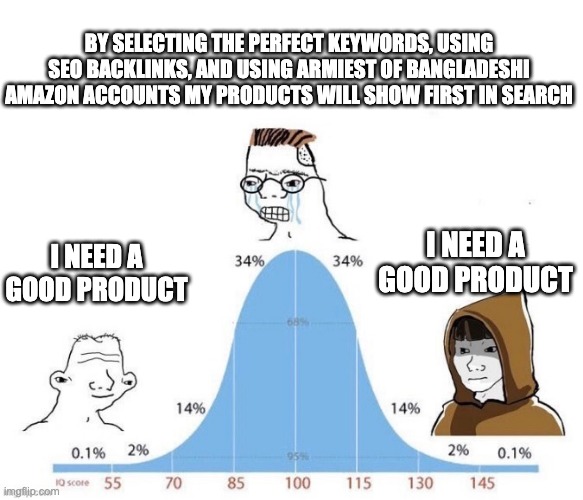
Does Amazon make money on the shipping and fulfillment it charges FBA sellers?
They don't reveal these data but there are clues implying this is a strong profit center.
Here's one example:
- $5.27 to ship out of our warehouse
- $7.48 to ship out of Amazon.

They don't reveal these data but there are clues implying this is a strong profit center.
Here's one example:
- $5.27 to ship out of our warehouse
- $7.48 to ship out of Amazon.


Here is a graph of 152 skus for which we have data.
When the red line is above the blue line, it means our shipping cost is higher than Amazon's.
When the blue line is higher, it means Amazon is more expensive.
When the red line is above the blue line, it means our shipping cost is higher than Amazon's.
When the blue line is higher, it means Amazon is more expensive.

To make this comparison apples to apples, remember:
- Amazon is including the cost of the box and fulfillment, we're not here ($0.30-$0.50 for us).
- Amazon has robots, we don't.
- Amazon has warehouses all over the country. We have one.
- Amazon is including the cost of the box and fulfillment, we're not here ($0.30-$0.50 for us).
- Amazon has robots, we don't.
- Amazon has warehouses all over the country. We have one.
- Amazon combines multiple products in a single package. In this comparison we did not do that (a few shipments snuck in). When we do we routinely get our shipping cost per unit $1 to $1.50
- Amazon has an entire delivery service. We pay USPS and FedEx to do that for us.
- Amazon has an entire delivery service. We pay USPS and FedEx to do that for us.

- We pay $0.50+ per unit to ship our units to Amazon where storage is over 20x the cost of our own warehouse.
- Amazon charges customers without prime shipping, we don't. For prime members, they get the prime membership fee.
- Amazon charges customers without prime shipping, we don't. For prime members, they get the prime membership fee.
- Amazon can get cheaper packaging than we can.
- Amazon is the biggest package shipper in the world. We're a small business that spent under $500k on warehousing shipping in 2020. They have way better negotiated rates than we do.
- Amazon is the biggest package shipper in the world. We're a small business that spent under $500k on warehousing shipping in 2020. They have way better negotiated rates than we do.
59% of our catalog is cheaper to ship out of Amazon.
42% of our catalog is cheaper to ship out of our warehouse.
If a small company with a single warehouse and no robots or package delivery can do that, I think it's safe to say that Amazon is making money on shipping.
42% of our catalog is cheaper to ship out of our warehouse.
If a small company with a single warehouse and no robots or package delivery can do that, I think it's safe to say that Amazon is making money on shipping.

Verify this data yourself by purchasing our products from both Amazon our website, just please do not verify the return shipping 😜
Our website: brainflakes.com/collections/sh…
Amazon: amazon.com/VIAHART-Interl…
Our website: brainflakes.com/collections/sh…
Amazon: amazon.com/VIAHART-Interl…
• • •
Missing some Tweet in this thread? You can try to
force a refresh














